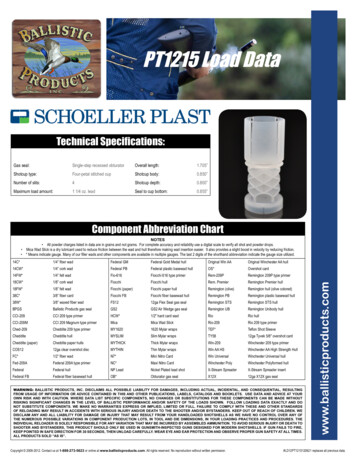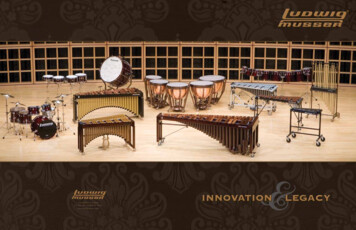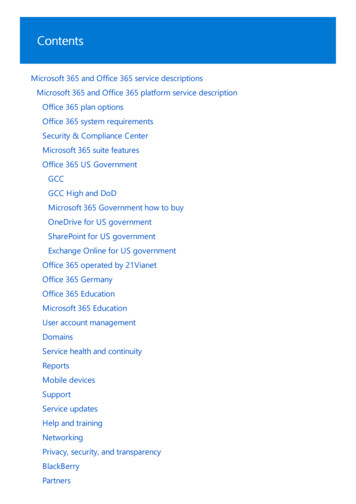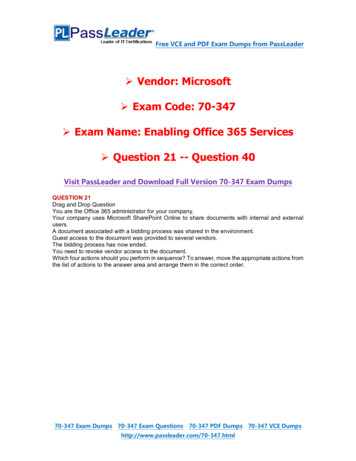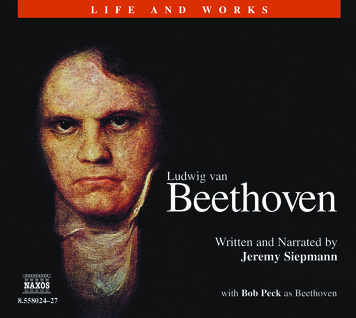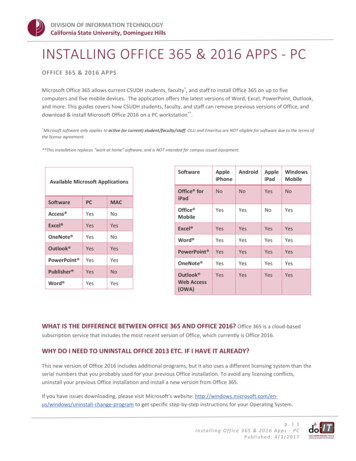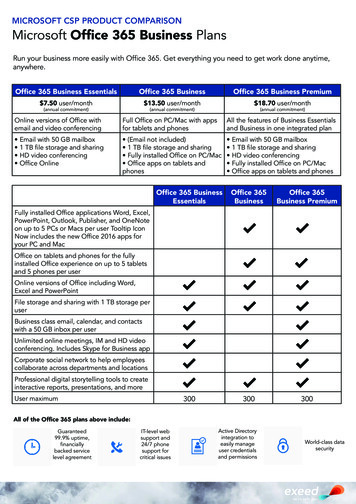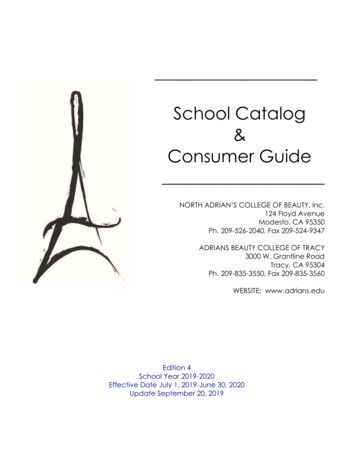
Transcription
DOCUMENT RESUMEED 365 209HE 027 000AUTHORTITLELudwig, Meredith; Wassan, HeidiStudent Charges at Public Institution: Annual SurveyINSTITUTIONAmerican Association of State Colleges andUniversities, Washington, D.C.; National Associationof State Universities and Land Grant Colleges,Washington, D.C.PUB DATENOTE881987-88.AVAILABLE FROMPUB TYPEEDRS PRICEDESCRIPTORS106p.; For related documents, see HE 027 001-003. Forthe 1988-89 survey, see ED 304 082.NASULGC Office of Public Affairs, One Dupont Circle,Suite 710, Washington, DC 20036-1191.ReportsResearch/Technical (143)StatisticalData (110)MF01/PC05 Plus Postage.*Access to Education; College Housing; *EducationalFinance; Enrollment Trends; Expenditure per Student;Financial Support; Higher Education; Inflation(Economics); Land Grant Universities; NationalSurveys; Parent Financial Contribution; *PublicColleges; State Colleges; *State Universities;*Student Costs; Student Needs; TuitionABSTRACTThe 1987 report on student charges at public collegesand universities presents data on the costs of attending about 90percent of the national publicly assisted. four-year institutions.The report uses data compiled by the American Association of StateColleges and Universities (AASCU) and the National Association ofState Universities and Land-Grand Colleges (NASULGC) from 507institutions responding to a survey. The analysis found that: (1)tuition, fees, room, and board expenses climbed an average of 5.4percent in fall 1987 over the previous year for in-state,undergraduate students; (2) an average of 1,500 for tuition and feesand 2,595 for room and board brought the price of full-timeattendance to 4,095; (3) tuition and fees for in-stateundergraduates averaged 1,456 in fall of 1987 a 6.4 percent increaseover the previous year; (4) out-of-state, undergraduate students paid5.8 percent more for full-time attendance in the fall of 1987 thanthe previous year; (5) graduate students paid an average of 1,648for in-state tuition and fees, a 6.6 percent increase; and (6)in-state first professional students paid average tuition and fees of 2,353 for law, 5,179 for medicine, 3,601 for veterinary medicine,and 3,601 for dentistry. The bulk of the document presents data infive tables. Appendices contain tables of undergraduate and graduatecharges by association, charges at non-affiliated colleges, andcharges for first-professional tuition and fees. *************************Reproductions supplied by EDRS are the best that can be madefrom the original ******************************
cz American AssociationIre4::,of State Colleges and UniversitieseelNational Association of State Universitiesand Land-Grant CollegesC omfkt-iccA iz.e5171-1eotrr or sfiker6Student Chargesat Public Institutions:%Ago et6M49Annual Survey :1? r Koress o I (--1-15fvuotlf r"p0P604.14IN)vo:#1-61U.S. DEPARTMENT Of EDUCATIONOffice of Educaboree Remerth end ImprovementEDUCATIONAL RESOURCES INFORMATIONCENTER fERICIi:14/14 elocumont ems Dmitri reproduC*0 uretoreed from the mrson or orgererst.onongeetting it0 Minot chervil's NAV been ma,:,improvereproductiOn isueleyPoints (Ave* o opnions stated in this docu-leant 00 not necssarily represent otfipalof pohcycow Doing,q0PERMISSION TO REPRODUCE THISMATERIAL HAS SEEN GRANTED BYNASULGCAAS CUTO THE EDUCATIONAL RESOURCESINFORMATION CENTER (ERIC)"
STUDENT CHARGESAT PUBLIC INSTITUTIONSANNUAL SURVEY 1987-88ByMeredith LudwigHeidi WassanAmerican Association of State Colleges and UniversitiesOffice of Association ResearchIn Cooperation WithGarven HudginsBob AaronKathy KoeslingNational Association of State Universities and LandGrant CollegesOffice of Communications Services
Copyright 1988 by American Association of State Colleges and UniversitiesNational Association of State Universities and Land-GrantCollegesWashington, D.C.
PREFACEA joint project of the American Association of State Colleges and Universities(AASCU) and the National Association of State Universities and Land-GrantColleges (NASULGC), the 1987 report on student charges at public colleges anduniversities describes the costs of attending about 90 percent of the nation'spublicly assisted, four-year institutions of higher education.In the past three years, the two higher education associations have beenreporting on the price of higher education and the factors driving priceincreases. This year, the report takes a closer look at the relationshipbetween price and supporting resources for students.The 372 AASCU-member institutions represented in this report enroll 2.7million students. Currently 61 percent of AASCU institutions arecomprehensive universities; 28 percent are general baccalaureate institutionswith primary emphasis on undergraduate education; and 5 percent aredoctoral-level institutions. AASCU members grant more than 300,000 bachelor'sdegrees annually--approximately 32 percent of the nation's total--about 27percent of the master's degrees awarded each year, and 7 percent of thedoctoral degrees.NASULGC, the nation's oldest higher education association, represents 149universities. Among these institutions are 24 of the largest multicampussystems of higher education in the country, including all of the major publicresearch universities and three private higher education institutions.NASULGC-member campuses enrolled about 2.6 million students in the fall ofNASULGC members award nearly half of all higher education degrees in1986.the United States, including about 60 percent of all doctorates.The public institutions reporting in this survey demonstrate a policy ofensuring access to quality higher education by maintaining low tuition. Thecooperation between the institutions that provide supporting financialresources--state and federal government and the private sector--and thecollege or university is the key to maintaining low tuition.Both associations have been recording changes in student charges for more than10 years. When in-state undergraduates planned their college expenses for1987, they found that, on the average, student charges--tuition, fees, roomThe rate of increase in studentand board costs--had climbed 5.4 percent.charges has been moderating in the past five years, coming closer to thatexperienced by other goods and services purchased by American consumers.The availability of grant and loan funds to help students finance theireducation costs is a key to ensuring broad access to higher education. Inrecent years, much has been written about the shifting balance in reliance onvarious types of student aid resources. The AASCU/NASULGC 1987 surveyrespondents were able to shed some light on this topic from their particularperspective.iii 5
The report concludes with an institutional listing outlining cost informationfor specific colleges and universities: undergraduate student charges;graduate student tuition and fees; and tuition and fees for students in theprofessional/schools of law, medicine, veterinary medicine, and dentistry.Both associations hope this report will be useful to consumers of highereducation, the public, the college and university community, and others inexpanding the information available on one aspect of higher education finance.cRobert L. ClodiusPresidentNASULGCAllan W. OstarPresidentAASCUJanuary 19886iv
TABLE OF CONTENTSPREFACEiiiFINDINGS1TABLE 1: 1987 Average Undergraduate Student Charges2TABLE 2: Average Undergraduate TUition/Fees Charges,Fall 1986 and Fall 1987 Comparison2TABLE 3: Average Undergraduate Room and Board Charges,Fall 1986 and Fall 1987 Comparison3TABLE 4: Average Graduate Tuition/Pees Charges,Fall 1986 and Fall 1987 Comparison3TABLE 5: Average First Professional Program Charges,Fall 1986 and Fall 1987 Comparison4TUITION AND FEES AS A REVENUE SOURCE4Moderation of Year-to-Year Price Increases4Balancing Price and Costs5Institutionally Funded Student Aid as an InstitutionalCost:The Current ndix A--AASCU Undergraduate Charges:Fall 1986 and Fall 198714Appendix B--AASCU Graduate Tuition and Fees:Fall 1986 and Fall 198726Appendix C--NASULGC Undergraduate Charges:Fall 1986 and Fall 198738Appendix D--NASULGC Graduate Tuition and Fees:Fall 1%6 and Fall 198744Appendix E--Charges at Nonaffiliated Institutions: Fall 198750Appendix F--AASCU, NASULGC, and Nonaffiliated FirstProfessional Tuition and Fees: Fall 1987527
FINDINGSTuition, fee, room, and board expenses climbed an average 5.4 percent in thefall of 1987 for in-state, undergraduate students attending public four-yearinstitutions on a full-time basis.Paying an average 1,500 for tuition and fees and 2,595 for room and boardbrings the price of full-time attendance to an average 4,095 in the fall of1987.These averages represent changes in two years of consecutive datacollected from public four-year institutions where on-campus housing isavailable. (See Table 1.)A total of 507 institutions out of 560 surveyed responded to the cooperativeeffort of the American Association of State Colleges and Universities (AASCU)and the National Association of State Universities and Land-Grant Colleges(NASuLGC). The two association memberships--372 AASCU and 149 NASULGCcampuses--represent 90 percent of publicly assisted, four-year institutions ofhigher education in the United States.Average tuition and fees and room and board charges separately calculated forall respondents show the rate of increase in student charges is moderating,approaching the increases in costs of higher education goods and services andother consumer prices.Tuition and fees for in-state undergraduates averaged 1,456 in the fall of1987--a 6.4-percent increase, compared with 1,369 the previous year. (SeeTable 2.)Average room and board charges were 2,598 in the fall of 1987--a 4.6-percentincrease over the 2,483 average for 1986. (See Table 3.)Tuition and fees for in-state undergraduates at AASCU campuses posted a6.0-percent average increase, climbing to 1,359 in the fall of 1987, comparedwith 1,282 in the fall of 1986. NASULGC-member colleges and universitiesregistered a 7.1-percent hike, bringing tuition and fee charges for in-stateundergraduates to 1,610 this fall, compared with 1,503 in the previouscanvass. Last year's survey documented increases in the 7.6-percent range.Out-of-state, undergraduate students paid 5.8 percent more for full-timeattendance in the fall of 1987. (See Table 1.) When the four basic componentsof the higher education sticker price are added together, these studentsliving on campus are paying considerably more, 6,405, reflecting the higheraverage price for out-of-state tuition and fees of 3,810. (See Table 1.)Graduate students paid 1,648 on the average for in-state tuition and fees, a6.6-percent increase from an average of 1,546 in 1986. Out-of-state graduatestudents faced a price of 3,795 for tuition and fees in the fall of 1987--a6.6-percent hike, compared with 3,560 in the previous reporting period.Average tuition and fees for in-state, first professional students in the fallof 1987 were: law, 2,353 (8.5-percent increase); medicine, 5,179(9.6-percent increase); veterinary medicine, 3,601 (12.0-percent increase);and dentistry, 4,921 (6.6-percent increase).NOTE: On the following tables, "N" equals the number of institutions permembership category responding to a given data set. Since the unit of analysisis association membership, institutions with overlapping membership are8
reported in each association category. The overall "N" will therefcre besmaller than the sum of "Ns" across all association categories. Table 1reports data only on instituticns providing tuition, fees, and room and boarddata for both 1986 and 1987.TABLE 11987 AVERAGE UNDEDGRADUATE STUDENT CHARGESWition/FeesRoom/BoardPct. E 2AVERAGE UNDERGRADUATE TUITION/FEES CHARGESFall 1986 and Fall 1987 Comparison19861987Pct. TEDOVERALL*The out-of-state charges for two institutions were reported as a range andcould not be used in computing the average.2
TABLE 3AVERAGE UNDERGRADUATE RCOM AND BOARD CHARGESFall 1986 and Fall 1987 TEDOVERALLPct. IncreaseTABLE 4AVERAGE GRADUATE TUITION/PEES CHARGESFall 1986 and Fall 1987 Comparison19861987Pct. EDOVERALL103
TABLE 5AVERAGE FIRST PROFESSIONAL PROGRAM CHARGESALL MEMBERSHIP CATEGORIESFall 1986 and Fall 1987 Comparison19861987Pct. 9.3%MEDICINEVETERINARY MEDICINEDENTISTRYTUITION AND FEES AS A REVENUE SOURCEMbderation of Year-to-Year Price IncreasesThe past 10 years have seen some fluctuation in the year-to-year rate ofincrease in student charges at public institutions. This year's reportdocuments a moderation in these price increases.The current rates of increase compare favorably with those of about 10 yearsago. Between 1977 and 1978, percentage changes averaged 4.3 and 5.5 percentfor public universities and four-year colleges. Current increases are comingcloser to what might be expected, given inflation, new costs, and compensationfor a labor-intensive sector.1 1.4
In the fall of 1987, 387 of the 507 respondents had tuition increases forundergraduate charges and 333 for graduate charges. Yet, most of the increaseswere modest.oIn 20 states, undergraduate state residents faced increases of 4percent or less.oIn another 21 states, undergraduate charges increased between 5 and 8percent.o Only 12 states and territories reported increasing undergraduatecharges at a rate of 9 percent or more.Balancing Price and CostsThe past three years of survey data about pressure points on institutionalexpenditures are substantially supported by this year's findings. It is theactual costs of operating the institution that are driving the year-to-yearincreases in student charges.oFifty-two percent of the institutions responding to questions about thereasons for price increases pointed to faculty salaries as the keyreason.oForty-four percent indicated costs of equipment replacement and repairwere driving tuition and fees increases.oForty percent highlighted inflation and the general costliness of goodsand services.oInsufficient appropriations or decreased support from stateappropriations was important enough to be noted by about 35 percentof the respondents.oIncreasing enrollments, increased demand for institutionally fundedaid, and recruitment and retention programs shared the same level ofimportance for needed additional revenue (17 percent).This year, in response to public criticism of the rates of increase intuitions, especially the double-digit increases in the early 1980s, economistsand researchers have looked at the driving forces behind tuition and feeincreases.Analyses by Carol Frances--based on the Higher Education Price Index (HEPI)developed by Kent Halstead--show that tuition and fees are being used: (1) tobalance losses in state appropriations that are the major revenue source forpublic institutions and (2) to cover the cost of "big ticket" itemsconfronting institutions during the 1980s, such as equipment replacement,employee benefits, and insurance. (1,2)512
Looking at the percentage change in cost flr a number of these goods andservices for all of higher education, alongside the increases in tuition andfees for four-year public institutions highlights this theory. It is the lesscontrollable cost items--such as employment taxes and fringe benefits,utilities, and books and periodicals--that have been outstripping the HEPI.Faculty salaries and equipment--the two categories frequently cited byinstitutions as fueling cost and price increases--have not increased asquickly as the overall HEPI, while fringe benefits and utilities are nearlydonble the rate of increase in the HEPI. However, faculty salaries andequipment replacement are becoming critical expenditures for all institutions,and that probably explains the view of institutions that they are moreimportant pressures on institutional costs. 2h increases in tuition and feesseem moderate when viewed over a longer petiod of time and in relationship toother items.Percentage changes were calculated from 1977-1985 since data was available forall items for those two periods of time.Indicators(All Higher Education)HRPIPercentage Change (1977-1985)84EquipmentFacplty Salaries61.767.7Books88.5Fringe BenefitsUtilities146154Percentage Change (1977-1985)Indicator(Public Four-Year Institutions)93Tuition and FeesIn a comprehensive look at tuition increases since 1970, Arthur Hauptman andTerry Hartle wrote that in the long term, tuition and fees at publicinstitutions have not been increasing at greater rates than items in theConsumer Price Index. "Finally, at public institutions, which enroll 80percent of all students, tuitions have grown at about the same rate asinflation and more slowly than income and the price of most other goods andservices." (3)36
Institutionally Funded Student Aid as an Institutional Cost: The CUrrentDebateSince the spring of 1987, higher education writers and researchers have beencalling attention to institutionally funded student aid as a new cost pressurefor campuses. According to reported HEGIS (Higher Education GeneralInformation Surveys annually conducted by the Center for Education Statisticsin the U.S. Department of Education) scholarship and fellowship expenditures,this item increased 61.5 percent (unadjusted for inflation) at four-yearpublic institutions from 1977-1985.Claims have been made that state and institutional efforts have becomeessential as substitutes for the grant aid lost from federal programs. Withnew data collection and analysis efforts underway, the questions aboutinstitutionally funded aid may soon be answerable. Currently, informationsupports the contention that expenditures for institutionally funded aid havegrown substantially.Resources available on this topic (Frances, National Association ofIndependent Colleges and Universities, College Board) indicate that problemsof definition, reporting, and analysis make this a complex issue. (5,6)For example, scholarship and fellowship expenditures collected as part of theHEGIS surveys tend to be the source of data on institutionally funded studentaid. However, in the past few years, federal Pell grant funds have beenreported as part of this data item and without careful subtractions, dataproviders and users risk overestimating the change in expenditures.In testimony to the U.S. Senate Subcommittee on Education, Arts andHumanities, the College Board reported three important student-aid trends:o "In real or inflation-adjusted terms student assistance generated byfederal programs declined 16 percent between 1980-81 and 1986-87."o"The real value of state grant aid has grown 47 percent and the realvalue of institutionally funded aid has increased an estimated 41percent."o"The funds are being shared by more students each year." (7)With inflation reducing the purchasing power of current aid dollars andrestrictions increasing on federal programs, borrowing outside the currentstructure is growing and is likely to continue. As Hansen and others havewitten, data on these borrowing habits and their implications for studentsand the country's economy are critical for making informed decisions aboutresource needs. (8)New analyses by the Anerican Council on Education reveal dramatic changes ininstitutional aid to needy undergraduates from 1979 to 1986. Using dataobtained from the U.S. Department of Education's Fiscal Operations Report andApplication to Participate data files, this latest trend analysis showd anincrease of 149 percent in current dollars and 60 percent in constant dollarsin aid going to students whose cost of college attendance is greater than theamount of money the family can afford to contribute. (9)714
The number of needy undergraduate students grew from 2.8 million to 3.8million in this same time period. This analysis represents changes at 4,071institutions reporting in 1979 and 4,733 institutions participating in thesame programs in 1986.The AASCU/NASULGC survey attempted to explore the issue of institutional andother nonfederal aid by asking about sources of revenue for this expenditureand the most commonly used form of nonfederal aid. The definition ofnonfederal aid used was any grant or loan that is not funded by the U.S.government. Institutionally funded aid was defined as campus expenditures forstudent aid.Th9 respondents to this portion of the AASCU/NASULGC survey (72 percent)indicated that institutional sources of aid are the most common form ofnonfedecal aid used by students to finance their education--47.9 percent.Institutional resources include need-based and merit-based grants (used atabout the same rate), scholarships, remissions, fellowships, and loans.State need-based and merit-based scholarships and loans are the other majorform of aid used by students--at a rate of 44.7 percent.Institutional aid, the respondents reported, is primarily fueled by resourcesother than tuition and fees. In fact, if resources from alumni, corporations,state appropriations, private donors, foundations, and that available throughtuition waivers and assistantships are combined, they would be the chiefsource of funds for institutionally funded student aid. Tuition and fees werereported as a source of aid at a proportion of about 28 percent.Only 51 percent of the survey respondents were able to respond to questionsabout the volume of aid and the number of students affected by the aid--eitheras applicants or recipients.oFor these institutions (including the large public higher educationsystems of New York, California, Florida) the aid volume haseAperienced a 27.2 percent increase from academic year 1984 to academicyear 1986.oThe number of students affected by the aid has increased 11.2 percent inthe same two-year period.SUMMARYThe rate of increase in student charges at public institutions has beenmoderating over the past 5 years. Economic uncertainties make predictions forthe next ten years difficult at best. As research has shown, the rates ofincrease are not currently exceeding the increased costs of other goods andservices purchased by the public or by higher education by more than whatwould be expected. This is especially apparent if individual items purchasedby higher education institutions are examined.A new wrinkle in the cost debate concerns institutional expenditures for aidto defray the price of attending college for students. These expenditures havenot yet increased at all institutions to the same extent as the cost of otheritems supporting instruction. However, data from the public institutions inthe four-year sector indicate that, as a cost item, institutional expendituresfor student aid will be growing as other traditional sources become morecostly or less accessible.815
METHOCOLOGYThe SurveyThe 1987 Student Charges survey forms were mailed in late September 1987, to560 public four-year institutions of higher education in the United States and115 to NASuLGC members, 352 to AASCU members, 20 to membersits territories:of both organizations, and 73 to other public four-year institutions notaffiliated with either association. Of these, 94 percent of the AASCU andNASULGC institutions and 63 percent of the nonaffiliated institutionsresponded to the survey.While most of the surveys were sent directly to the participating campuses,roughly 20 percent of the surveys were mailed to the state system officesresponsible for multicampus student charges information.Survey forms contained figures for 1986 student charges received from lastyear's canvass. Participants were requested to review these figures and makecorrections to ensure accurate and consistent year-to-year comparisons.Survey respondents were asked to report annual charges for tuition andmandatory fees, and for room and board. Guidelines accompanied the surveyinstructing respondents to base their figures on typical undergraduate andgraduate student course loads. It was suggested that 30 or more credit hoursbe used for undergraduate students and 18 or more credit hours for graduatestudents in calculating the annual student charges. If institutions assesseddifferent charges for upper and lower levels, respondents were instructed toprovide the average of typical charges at the two levels.The actual fees paid by students may vary from those in this report because ofstudent choice of course loads and room and board plans.The AnalysisCompleted surveys were returned from 507 institutions. Not all data received,however, were complete and comparable. Institutions providing questionabledata were contacted by telephone.Many of this year's respondents did not participate in the 1986 survey andwere not able this year to provide 1986 data. In order to perform accurateyear-to-year comparisons, institutions were included in the calculation ofaverages only if they provided data for 1986 and 1987 for the particular dataitem being analyzed (for example, undergraduate tuition and fees or room andEach data item was considered separately.board).In the case of Table 1, only institutions providing 1986 and 1987 data fortuition and fees and combined room and board were included in the averages.The institutional categories used in the analysis are NASULGC members, AASCUmembers, and nonaffiliated institutions. The AASCU and NASULGC categorieseach include the institutions that hold memberships in both associations.916
The nonaffiliated institutions were given their own category, sincecharacteristics and missions of these schools often are very different thanthose of the AASCU and NASULGC members. within this group, for example, arehealth science and medical centers, mining and technology schools, branchcampuses with unique missions. The U.S. Armed Services academies, consideredpart of the nonaffiliated category, have been excluded entirely from thisreport since they are supported by the federal government and assess nostudent charges.All of the institutions analyzed in this report are state assisted, and theirstudent charges are established and regulated by system and institutionalgoverning boards within each state. Consequently, there is, for the mostpart, consistency among public institutions within the same state.Some variations do exist even within the same state, however, as can be seenin the reports of actual data in Appendices A,F. Variations can be attributedto such factors as a range of mandatory fees, differing course loadcalculations, and diversity of institutional missions. For example, aninstitution whose mission is to provide an opportunity for students to earndegrees while external to the campus will have lower charges than moretraditional four-year undergraduate campuses. Likewise, student charges atinstitutions that offer training in specialized fields, such as engineering,will be more costly than at liberal arts campuses.Institutions also follow particular reporting conventions in providing studentcharges information. Some respondents reported annual student charges for atypical full-time student based on the number of credit hours taken each yearto graduate in four years. Others reported the credit hour base to be thetypical load for their undergraduate student, usually 12 hours or 15 hours asemester.Variation in mandatory fees should also be noted. In some states a range isdefined by the governing authority for particular fees, and institutionsdetermine the actual amount assessed. This can make overall charges for oneinstitution look lower or higher than another within the same system, when infact tuition charges are identical.In a few isolated cases, where year-to-year student charges increased by aninordinate amount and resulted from exceptional circumstances (for example,change from quarter system to semester system) institutions have been excludedfrom the average analyses. All institutions responding to the survey arelisted in the appendices.1017
1. Carol Frances, A Factual Analysis of the Economic PremisesUnderlying the Administration's 1988 Budget Proposals for Higher EducationWirginia: Carol Frances & Associates, February 1987).2. Research Associates of Washington, Higher Education Price Index(Washington, DC: annual).3. Arthur Hauptman and Terry Hartle, "Tuition Increases since 1970: APerspective," Higher Education & National Affairs, 23 February 1987.4. Frances.5. National Institute of Independent Colleges and Universities, TheTruth About Costs In The Indrendent Sector of Higher Education(Washington, DC: NIICU, 1987.6. Gwendolyn L. Lewis and Jamie P. Marisotis, Trends in Studmt Aid:1980 to 1987 (New York: College Entrance Examination Board, November1987).7. Lawrence E. Gladieux, "Trends in Student Aid and PossibleLegislative Remedies to Reduce Student Loan Defaults," Testimony to theSubcommittee on Education, Arts and Humanities, Committee on Labor andHuman Resources, U.S. Senate (Washington, DC: The College Board, December1987).8. Janet S. Hansen, Student Loans: Are They Overburd
tuition, fees, room, and board expenses climbed an average of 5.4 percent in fall 1987 over the previous year for in-state, undergraduate students; (2) an average of 1,500 for tuition and fees and 2,595 for room and board brought the price of full-time attendance to 4,095; (3) tuition and fees for in-state
